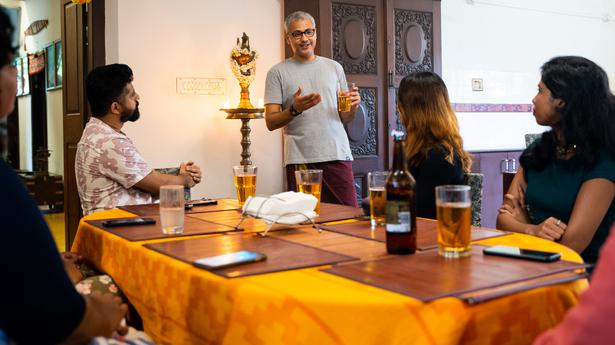Mumbai-based researcher cum chef Gaurav Shah recreated his grandmother’s recipes
The horseshoe-shaped dining table at the over 100 years old Govindamangalam Homestay, in Kochi, can seat 12. Designed to facilitate serving ela sadya, the elaborate vegetarian Kerala meal had on a banana leaf, it recently hosted a four-course Konkani food sit-down for a large group of keen food lovers. Created by Mumbai based researcher cum chef Gaurav Shah, it was one of the first food pop ups hosted in the heritage home.
“It is interesting to travel with Konkani food,” says Gaurav Shah who chose to unfold his second Konkani cuisine experience in an environ where traditional food blended with old-world settings. The ambiance created by well-appointed period furniture, clocks, artefacts, furnishing and the daily life of the homestay, it carried a charming feel of a time gone by. Gaurav’s first pop up was held at a Kashmiri restaurant in Siolim, in Goa.
Inspired by “the smell, taste and feel” of his grandmother’s recipes, Gaurav began recreating them during the pandemic. He started by preparing and sending food across to people in his neighbourhood who were stranded or unable to prepare meals during the lockdown. It resulted in him receiving regular orders. The unhurried days helped him organise recipes, rate popular choices, experiment with special dishes, check availability of authentic ingredients and launch his outfit, Yeto, which means See You again.
Pomfret curry with rice
Four-course meal
The four-course meal consisted of tiger prawns, as starters, marinated in “house spices”, which Gaurav says is a secret, followed by rice paired with mango curry made with semi ripe mangoes, succeeded by an aromatic pomfret curry with sol kadi, a Konkani kokum drink made from kokum or aamsol and coconut milk. The meal ended with Rawa(semolina) fried banana and Tirphal (a variety of Szechuan peppercorn) kadi.
The starters were served in a bamboo box, “to retain the aroma of the spices,” the semi-ripe mango curry is generally made using “Lal Bagh mangoes,” which are elongated with a soft green and red skin. Also called Honey mangoes, they are known for their sweetness. The rice platter had a mango pickle, a version of the famed Andhra avakaya pickle. “Pomfret is one of the most popular fishes of the region,” says Gaurav adding that mandeli (anchovy), bangada (mackerel), surmai (King Fish), Bombay duck, tisrya (clams) and mud crabs are other sea fare that is used in Konakni cuisine
The Sol Kadi, he explains is served “as concentrate, which is like a digestive and palate cleanser.”
“Konkani cuisine is not big on desserts and sweets are eaten at odd times, like “banana sheera(halwa) at breakfast and sakharbhat(sweet rice) at lunch,” says Gaurav who served rawa coated fried banana as a sweet finish. It was accompanied by a drink made with triphala and coconut milk, “an extremely aromatic drink.” “triphala is used for infusion and elevates the sensory experience. It may look very unassuming but has a lot of depth.”
Konkani and Mangalorean cuisine
Gaurav talks in detail about the subtle differences in Konkani and Mangalorean cuisine, of the two curries- kalwan and gussi– common to the region.
“Both are curries with concentrated, complex flavors and differ in the use of ingredients. The local chilli or tamarind imparts a different taste but gussi is bold in flavour, while kalwans can be subtle,”

Govindamangalam Homestay in Kochi
| Photo Credit: Special arrangement
As Gaurav takes diners through the food history and culture of the Konkan region, one is transported to his grandmother’s kitchen, of sitting on a mat on the floor, of the aroma of herbs and spices, of a warmth and of overheating…
“Food is memory…” he says pleased to share a culinary culture that connects the coastal food of India in more ways than one.




.jpg)


